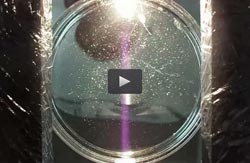Researchers find the macroscopic Brownian motion phenomena of self-powered liquid metal motors

This video shows hydrogen bubble tails generated from a swarm of self-powered liquid metal tiny motors which were distinguished through high contrast optical images. It indicates that these tiny motors kept swiftly traveling here and there, just like a fairy. Credit: ©Science China Press
Ever since the irregular motions of suspended grains in water was observed by Brown in 1827, tremendous efforts have been made on establishing a theory to characterize the Brownian motion. After almost a half century later, the kinetic theories of heat developed by Maxwell, Boltzmann and others were merging as a possible explanation.
In 1905, Einstein published a theoretical paper interpreting the stochastic process using particle diffusion constant and the fluid viscosity. This relationship bridges the microscopic dynamics with the macroscopic phenomenon, which inspired many subsequent works regarding both thermodynamics and statistical physics. Such theory was later demonstrated by the well-known Perrin's experiments.
So far, most of the classical Brownian motions refer to the molecules activities that occur in microscale. There are very limited reports to investigate such phenomena in macroscale. And the ever tackled phenomena are mainly focused on the particle motions caused by the surrounding liquid molecules.
In this study, researchers disclosed that macroscopic liquid metal motors in millimeter scale showed similar Brownian motion behavior in alkaline solution. The authors dispersed the premixed liquid metal and Al (mass percentage 1%) alloy into a glass Petri dish. It was observed that each tiny motor in millimeter scale began to move swiftly and randomly on Petri dish glass.
Contrary to the classical Brownian motion behavior, the main driving force of such motion comes from the hydrogen bubbles generated at the bottom of the tiny motors. Such tiny motor differs in moving mechanism with its counterpart large size self-fueled liquid metal machine which was mainly driven by the electrochemically induced surface tension.
Further, an optical platform with high image contrast, which works somewhat like the Wilson Cloud Chamber, was introduced to clearly depict the hydrogen bubble stream left behind the running motors.
The present findings add important new knowledge to the liquid metal motor as well as the classical Brownian motion phenomenon. The established optical image contrast method also provides an important experimental tool for further investigations along this direction.
###
This research was partially supported by the Research Funding of the Chinese Academy of Sciences (No. KGZD-EW-T04-4).
See the article:
B. Yuan, S. Tan, Y. Zhou, J. Liu, “Self-powered macroscopic Brownian motion of spontaneously running liquid metal motors,” Sci. Bull. (2015) 60(13):1203-1210. http://link.
Media Contact
All latest news from the category: Physics and Astronomy
This area deals with the fundamental laws and building blocks of nature and how they interact, the properties and the behavior of matter, and research into space and time and their structures.
innovations-report provides in-depth reports and articles on subjects such as astrophysics, laser technologies, nuclear, quantum, particle and solid-state physics, nanotechnologies, planetary research and findings (Mars, Venus) and developments related to the Hubble Telescope.
Newest articles

Bringing bio-inspired robots to life
Nebraska researcher Eric Markvicka gets NSF CAREER Award to pursue manufacture of novel materials for soft robotics and stretchable electronics. Engineers are increasingly eager to develop robots that mimic the…

Bella moths use poison to attract mates
Scientists are closer to finding out how. Pyrrolizidine alkaloids are as bitter and toxic as they are hard to pronounce. They’re produced by several different types of plants and are…

AI tool creates ‘synthetic’ images of cells
…for enhanced microscopy analysis. Observing individual cells through microscopes can reveal a range of important cell biological phenomena that frequently play a role in human diseases, but the process of…





















